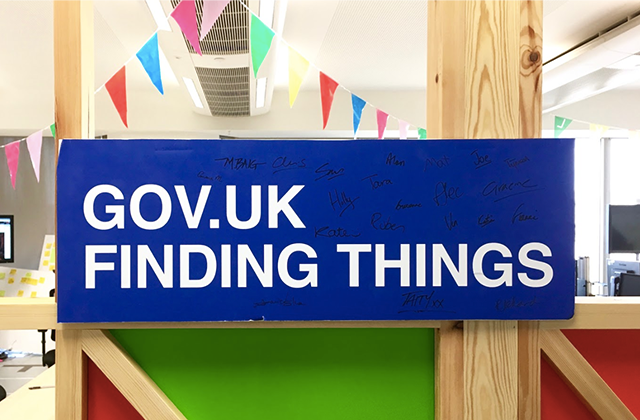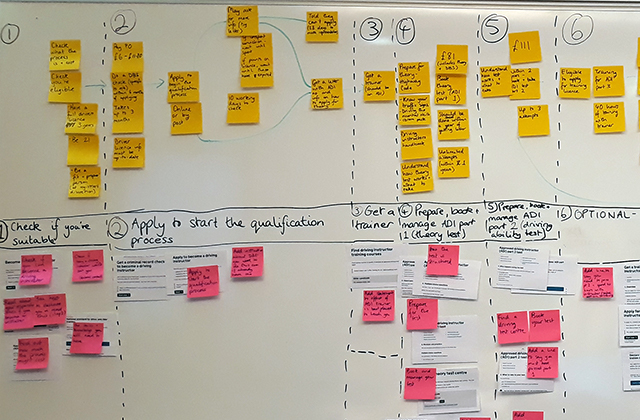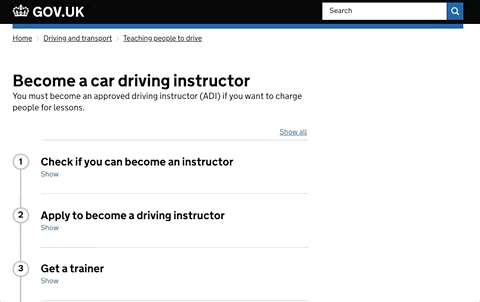
Every year, thousands of people use GOV.UK to find out how to become a driving instructor, start the qualifying process and book the tests involved.
There’s a lot of information you’ve got to find, transactions to complete, and you’ve got to do it in the right order.
The qualification process is tough - and rightly so. It’s important that learner drivers are taught by instructors who are skilled experts. Between April 2016 and March 2017, over 7,400 people applied to start qualifying. During the same time, only around 1,700 people actually qualified.
Guiding users through complex tasks
We think one thing contributing to this is that there’s no one place on GOV.UK that clearly sets out this process. No single place to see what you need to do, in what order, and what it might cost.
And that’s where GOV.UK’s new step by step navigation comes in. It’s a new feature designed to help guide users through complex tasks. It makes it clear where you are in the overall process, and helps you back to previous steps if you’ve missed something out.
Designing step by step navigation to become a driving instructor
We were really excited when we saw step by step navigation being developed on GOV.UK for learning to drive a car.
After that had been published, I didn’t have any difficulty in finding service managers and policy experts who wanted to improve the navigation through their services and content. In this case, it was Jacqui Turland and Jo Bembridge - our service and policy experts for driving instructor registration.
We arranged a half-day workshop with Jon Sanger and Gabrielle Acosta from the Government Digital Service (GDS). It was great that GDS we’re able to come to us in Nottingham, as it helped make sure our busy policy experts could be with us.
It was really encouraging to see that the team from GDS had already been looking at the content in the journey and had pulled together loads of useful data about it.

We went on to map out the whole journey for becoming a driving instructor. And importantly, we didn’t just limit this to what the user needs to do with DVSA.
When you’ve become a driving instructor, you might want to set up your own driving school, which means setting up as a sole trader, registering with HMRC, and naming your business following rules from Companies House.
When we had the journey mapped out, we started mapping the content and transactions that are involved onto it.
Building the page
After the workshop, GDS started to build the step by step navigation for us, and we kept providing feedback.
When we were happy with everything, we went through our normal fact check process to make sure everything was factually accurate.
We then held a short demo with the team who process driving instructor applications so they knew what to expect and could ask questions.
And then the exciting bit - it was published.
The early results are encouraging
The new step by step navigation is being used - a lot.
Become a car driving instructor has already been used over 10,000 times in its first month.
And we know from users that they are finding it useful.
Every GOV.UK page has a blue banner at the bottom of it, asking users whether the page is useful to them.
So far, 77% of users have found the page useful. This is well above the site average of 54% for guidance pages.
What we learned
We’ve learned a lot from putting together this step by step navigation page. Here are 4 of our highlights.
1.You can’t fix everything on your own
Working together is really important. We can’t fix navigation through complex services on our own. We need to work together to do it.
We’ve been really impressed with what can be achieved when we work together and sit down to understand the problems we’re trying to fix.
We at DVSA couldn’t have built this on our own, and GDS couldn’t have built it without us.
2. It’s always good to review a process
It’s not the first time that we’ve mapped out the process of becoming a driving instructor. It’s something we’ve looked at before to understand how we can improve our processes.
But even having done it before, we found it useful to do again - and especially with people in the room who weren’t subject matter experts. It made us challenge assumptions we’d have made had we just done this by ourselves.
3. You’ll find content that needs improving
Going through the process has helped us identify content that, until now, we thought was fine - but can actually be improved.
Seeing content and transactions set out in the context of the wider end-to-end service gives you a new understanding of how things fit together. It helps spot things from page titles that could be clearer, right through to parts of the service that maybe don’t hand off as well as they could.
This is, of course, a good thing. It can only help make things simpler for users.
4. As one journey ends, another begins…
Working on this end-to-end service was really interesting. It was all about qualifying to become a driving instructor. It’s the end of the journey, but not the end of the story.
When you’re qualified, there are still things you need to do. Some of them will be things you might do every day or week (like giving driving lessons and booking driving tests), through to things you’ll do every 4 years (like renewing your driving instructor registration).
So we know this end-to-end service of becoming a driving instructor now needs to hand off to other step by step pages that help you through being a driving instructor. And that’s what we’ll be working on next.
Keep up to date with our work by signing up for email alerts or following DVSA digital on Twitter. You can also follow John on Twitter @johnploughman.
